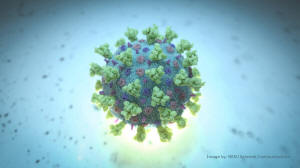Common cold antibodies hold clues to COVID-19 behavior; lung scans speed
COVID-19 diagnosis in stroke patients
 Send a link to a friend
Send a link to a friend
 [November 07, 2020]
By Nancy Lapid [November 07, 2020]
By Nancy Lapid
(Reuters) - The following is a roundup of
some of the latest scientific studies on the novel coronavirus and
efforts to find treatments and vaccines for COVID-19, the illness caused
by the virus.
Common cold antibodies yield clues to COVID-19 behavior
Among people who were never infected with the new coronavirus, a few
adults - and many children - may have antibodies that can neutralize the
virus, researchers reported on Friday in Science. Among 302 such adults,
16 (5.3%) had antibodies, likely generated during infections with
"common cold" coronaviruses, that reacted to a specific region of the
spike protein on the new virus called the S2 subunit. Among 48 children
and adolescents, 21 (43.8%) had these antibodies. In test tube
experiments, blood serum from both older and younger uninfected
individuals with cross-reactive antibodies could neutralize the new
coronavirus. That was not the case with serum from study participants
who lacked these antibodies. "Together, these findings may help explain
higher COVID-19 susceptibility in older people and provide insight into
whether pre-established immunity to seasonal coronaviruses offers
protection against SARS-CoV-2," the publishers of the journal said in a
statement. The findings also suggest that targeting the S2 subunit on
the coronavirus spike protein might be the basis for a drug or vaccine
that works on multiple types of coronavirus. (https://bit.ly/3evCSFB)

Lung CT speeds COVID-19 diagnosis in stroke patients
In emergency-room patients with stroke, lung imaging studies can help
detect COVID-19 before results of nasal and throat swab tests come back,
researchers say. Stroke can be a sign of COVID-19, but swab results can
take days to become available. At three New York City hospitals in March
and April, doctors ordered computed tomography angiograms (CTA) on 57
stroke patients within 24 hours of hospital admission, to look for
COVID-19-related pneumonia. Thirty patients turned out to have COVID-19,
based on their nasal swab results. But the CTA scans, in combination
with patients' symptoms like cough and shortness of breath, allowed for
the diagnosis of COVID-19 with 83% accuracy before the swab test results
were received. Screening stroke patients for possible COVID-19 based
only on symptoms is unreliable, because they may not have symptoms or
they might not be able to speak, the researchers point out in their
report in the American Heart Association journal Stroke. "Early
diagnosis via CT scans has helped our center protect other patients and
staff through early isolation, and it has also allowed us to start early
supportive care for those suspected of having stroke who are COVID-19
positive," coauthor Dr. Charles Esenwa of the Montefiore Medical Center
said in a news release.
[to top of second column]
|

A computer image created by Nexu Science Communication together with
Trinity College in Dublin, shows a model structurally representative
of a betacoronavirus which is the type of virus linked to COVID-19,
better known as the coronavirus linked to the Wuhan outbreak, shared
with Reuters on February 18, 2020. NEXU Science Communication/via
REUTERS

New coronavirus sneaks out of cells "with the trash"
The new coronavirus uses a surprising pathway to exit infected cells
and go on to infect others, researchers have discovered. It hijacks
a cell structure called the lysosome, which is normally where
cellular trash goes to be destroyed. But the virus uses lysosomes as
escape hatches, the researchers report in Cell. "To my knowledge
coronavirus is one of 2 or 3 viruses to do this, and certainly the
only enveloped virus," said coauthor Nihal Altan-Bonnet of the
National Heart Lung and Blood Institute, referring to viruses that
have a membrane surrounding their genetic material. "All other
enveloped viruses ... use other pathways for cell-to-cell spread,"
Altan-Bonnet added. These include influenza, hepatitis C, Dengue,
Zika, West Nile and Ebola. When lysosomes degrade bacteria and
viruses into little pieces, she explained, "these little pieces get
presented on the surface of the cell to alert the immune system" to
the invaders' presence. By using the trash disposal system of the
cell to get out, the new coronavirus disables the lysosome and
disrupts alerting the immune system, she said. "We believe our
discovery of the pathway used by coronaviruses to get out of cells
will be fundamental to our understanding of how these viruses wreak
havoc on our body, in particular our immune system."
(Reporting by Nancy Lapid; Editing by Bill Berkrot)
[© 2020 Thomson Reuters. All rights
reserved.] Copyright 2020 Reuters. All rights reserved. This material may not be published,
broadcast, rewritten or redistributed.
Thompson Reuters is solely responsible for this content.

 |